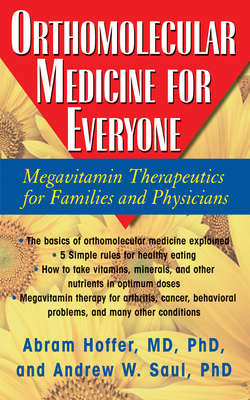Читать книгу Orthomolecular Medicine for Everyone - Abram Hoffer M.D. Ph.D. - Страница 9
What Is OrthomolecularMedicine?
ОглавлениеThe basis for health is good nutrition. When malnutrition or starvation is present, it is impossible to respond effectively to any medical treatment. Orthomolecular, the word coined by Linus Pauling in 1968, describes a method that uses nutrients and normal (“ortho”) constituents of the body in optimum amounts as the main treatment.1 Orthomolecular physicians use all modern treatments, including drugs, surgery, and physical and psychological methods, when these are appropriate. For example, when antidepressants or tranquilizers are needed, they are used in conjunction with the nutrients and nutrition. The drugs are used to gain rapid control over undesirable or disabling symptoms and are slowly withdrawn once the patient begins to respond to orthomolecular treatment. Surgeons using nutrition have found that their patients respond more quickly after surgery and suffer fewer undesirable reactions. Since all people are healthier when they eat food only (avoiding junk and artifact), they can resist disease and injury more effectively when they are healthier due to optimum nutrition.
Orthomolecular nutrition, in contrast to “eat the food groups” nutrition, emphasizes the use of supplemental vitamins, minerals, and other accessory factors in amounts that are higher than those recommended by the government-sponsored “dietary allowances.” Furthermore, orthomolecular nutrition is employed to treat illnesses that are not considered traditional deficiency diseases. Two examples would be using tens of thousands of milligrams of intravenous vitamin C to fight cancer or using several thousand milligrams of niacin per day to treat psychosis.
The major emphasis on nutrition and nutrients sets orthomolecular physicians apart from other physicians, who seldom show any interest in the nutritional condition of their patients and are generally resistant and even hostile to the use of vitamins and minerals. These physicians depend almost entirely on drugs, surgery, and radiation. Nonmedical professionals such as psychologists and nutritionists can advise patients about nutrition. Even though they are not allowed to practice medicine (i.e., prescribe drugs), they are able to help many persons regain their health. But the majority of orthomolecular practitioners are physicians.
Few medical schools provide their students with a useful understanding of the importance of nutrition in generating disease and how to correct diet when they treat patients. Physicians have abdicated their responsibility in favor of nutritionists (who are usually biochemists) and dietitians. Very few clinical nutritionists practice in hospitals, so it is not surprising that hospitals are so naive about nutrition and that most of their patients suffer more from malnutrition on discharge than they do on admission. Medical students pay little attention to nonclinical nutritionists. It is clear to many of them that nutrition must be unimportant in the hierarchy of medical specialties and that it plays no role in medical practice. But orthomolecular physicians have adopted nutrition as a main component of any medical, surgical, or psychiatric treatment.
